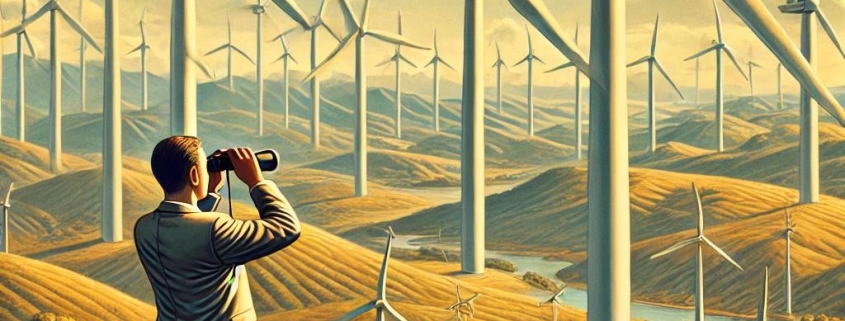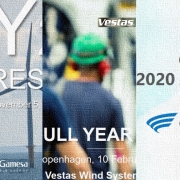Windturbine observer’s guide
When I pass by a wind farm, I can’t help but try to distinguish the manufacturer and model of wind turbine. And I think I’m not the only one, so this article is intended to help you to be able to identify at a glance the different wind turbines that can be seen in the fields and mountains of Spain… let’s go with the windturbine observer’s guide.
Step 1: Large or small turbine?
It seems an obvious question, but with the large distances and without reference elements, it can be difficult to guess the dimensions of a wind turbine. Therefore, the easiest thing to do is to look at the rotational speed (as long as they are rotating, of course). Older models such as the G47 had a very high maximum rotational speed of almost 30 rpm (revolutions per minute) while current models of 5 MW or higher rotate at about 10 times per minute. The 2 MW models spin at about 20 rpm maximum but are usually around 15 rpm.
Of course, there is no need to calculate the speed of rotation; simply, if it looks like a pinwheel, it is a turbine of less than 2 MW. If it spins very slowly, it is a modern high-capacity model, and if it is something in between, it is probably 2-3 MW.
Step 2: Ok, It is a small turbine, but which is the most common?
This is the most likely case as the number of turbine units up to 2 MW is very large. And maybe we will be lucky and the nacelle will have the manufacturer’s logo, which was quite common in the early 2000s but soon changed when customers started to ask for turbines to be identified with their own logos.

Units of models up to 2 MW installed in Spain
As can be seen in the graph above, there is almost a third probability that it is a Gamesa G47, G52 or G58, which are the most installed models in Spain by number of units. Distinguishing these 3 models is for the advanced course as they are practically identical. To this we must add the Vestas V47 and V52, and even the MADE AE 46, also virtually identical to the previous ones. All 6 models are characterised by their box-shaped nacelle which narrows at the rear.

Step 3: Identifying simple cases
Any windturbine observer worth his salt should be able to distinguish certain very characteristic manufacturers and/or models.
- Enercon
With its classic egg-shaped nacelle on all older models, it is perhaps the easiest to identify.

Also, for the eagle-eyed, Enercon used to label the model on the nacelle.
In Spain, the most commonly installed are the E-70 and E-82, although if it spins very fast, it is probably an E-40. There are also E-40s with the generator protruding in a very curious configuration.

As if all these clues were not enough, there is another trick to identify Enercon and it is thanks to their towers painted with the famous (and registered) green gradient.

For the advanced students, if they pass through Navarra, they could confuse the machines of the manufacturer MTorres with Enercon models. They are very similar but the back of the egg is truncated.

- Former Siemens/Bonus
Others that are very easy to identify thanks to their cylindrical nacelle and prominent “nose”.

In Spain there are Bonus 44/600, 1.3 and SWT 2.3 with this shape. The Bonus were manufactured by Izar so maybe they have the name somewhere.
- MADE AE 5X
MADE’s AE 5X models were quite popular and are easy to identify by the shape of the nacelle with the spoilers rising up its line.

- Ecotecnia ECO44 and ECO48
Another very characteristic model with its almost square nacelle and the side print

- Acciona AW 3000
One of the most beautiful nacelles in wind power history. With its cylindrical shape and truncated “aerodynamic” rear with an oblique section, its profile is easy to identify. And although this is an unchecked fact, I seem to remember that when it was launched it was said that a famous sculptor had worked on the design. I’m sure a reader of the blog will be able to clarify this for us.

- Neg Micon
Other easily identifiable older models are those of the Neg Micon company (bought by Vestas). They are characterised by the hollow protrusion at the rear and the straight side tread joining the hub to the rear.
![]()
In Spain you can find quite a few NM44 and NM48. Be aware that they can be confused with the Nordex N80 and N90 which also have the protrusion but do not have the side tread. Also, there are very few N80 or N90 installed in Spain so it is unlikely to find any.

default
Step 4: With 1.5-2 MW models the difficulty rise up
If the era of turbines under 1.5 MW was characterised by a variety of designs and shapes, the years of 1.5 to 3 MW were the years of standardisation. With the advent of the cost-cutting culture, all manufacturers tended towards functional and, unfortunately for wind turbine enthusiasts, very similar designs.

Source: wind power models and others
If the manufacturer is not labelled, it is very difficult to quickly identify the model at a glance. The Gamesa G8X, the Vestas 2 MW, the GE 1.5, the Acciona AW 1500 and even the Ecotecnia 1.67 MW are really similar. The super experts surely have tricks to identify them, but this is really for the pros.
Step 5: the giants of the road
And then we come to the most spectacular models. The ones that rotate very slowly but you can see how their giant blades flex in an incredible way to better support the loads. They are not easy to distinguish but we will try to give some clues.

Source: websites
- Siemens Gamesa SG 5.X: the most characteristic feature is its “belly” which is the trafo. I think it is not the only model that can go in that configuration but it seems that in the 5.X it is the standard configuration. We’ll see if the redesign that is taking place changes anything. There are not many installed because of the pause in its commercialisation but at least Repsol has already installed some in Burgos, in the Cerrato II park.
- The Nordex 4 and 5 MW are characterised by their “flat nose”. This is common to the SG 5.X and GE Cypress but in the Nordex, the hub has a rather square shape. Also, the rear structure for passive cooling is very wide. Another clue that points to the Nordex machine is the concrete tower as it is the only manufacturer of the 4 that uses this material for its towers.
- Vestas EnVentus: it is characterised by its “container” nacelle and its rear passive cooling similar to that of Nordex. If equipped with the side container with electrical equipment, then it is unmistakable.
- GE Cypress: the longest nacelle and the one with the smallest hub. It also has no nose so it gives the impression of having a “small head”.
We hope this review has been educational and enjoyable. It is not recommended to try to apply the teachings of this guide if you are driving because of the danger of distraction. But if you are a passenger, whether you are in a car, train or even an aeroplane, go fearlessly on the hunt for the wind turbine!










